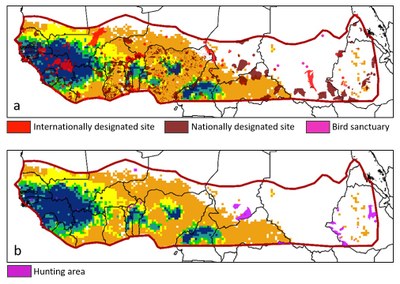Species conservation – an integrative approach
Research on the European Turtle Dove (Streptopelia turtur) using different methods
The European Turtle Dove (Streptopelia turtur), as the only long-distance migratory columbid species in Europe, has breeding sites in Europe, Asia as well as North Africa. Its wintering areas , which it reaches via the western, central or eastern flyways, are in the sub-Saharan (Sahel zone). It has been classified as "vulnerable" on the IUCN Red List due to its rapidly declining population, an europewide decline of around 80% compared to the 1980s. To plan conservation measures, more extensive species knowledge was required, e. g. regarding habitat requirements and spatial distribution1, population connectivity2, migration routes3, and wintering areas4.
Therefore, for a Germany-wide study, species distribution models based on presence-absence (PA) data were compared to those based purely on presence (PO)1. Climate and land use data were integrated as environmental variables1. The resulting PO maps proved to be more differentiated and revealed foci in the areas of Saarbrücken, Düsseldorf, the Black Forest lowlands as well as Lusatia1. The climate variable of January temperatures was shown to be significant as it can influence factors such as food availability and breeding sites as well as increased breeding success1. The performance of the land coverage data could be optimized by introducing further variables to obtain more precise information on habitat characteristics1.
More detailed information on population connectivity was obtained by a study that used stable hydrogen isotopes (δ2H) investigating turtle dove feathers from 13 countries2. The method is suitable because feathers provide geographic information of their place of origin since they are metabolically inactive after growth. First, feather samples of known breeding origin were used to calibrate a European hydrogen isolandscape2. Next, feather samples from stopover sites during migration to the sub-Sahara were collected and matched to the resulting isoscape, allowing them to be assigned to breeding territories2. Four broad regions of origin corresponding to a temperature gradient from cool/humid to hot/dry were identified2. For example, feather samples taken in Bulgaria could predominantly be assigned to Russian breeding areas2.
As the previous use of ring data for monitoring migration movements outside the breeding season of Turtle Doves proved to be insufficient due to low recovery data from Africa, Argos satellite transmitters were used in a further study from 2016 to 20203. With the help of these, detailed information on migration strategies as well as qualitative statements regarding the environmental conditions of the breeding and wintering habitats should be obtained through year-round data recordings3. In combination with the analysis of land use data, the evaluation of results confirmed the use of multiple wintering habitats3. The previous assumption that a mix of cropland and cultivated landscapes is used for breeding areas was also confirmed3. Differences were found between breeding and wintering areas with respect to most environmental parameters and niche width, as well as site fidelity to breeding sites3. In addition, it was demonstrated that with higher proportions of agricultural land, the size of the home range increased3. The tracking data also showed that most Turtle Dove individuals spent extended periods of time in stopover sites in Europe, e.g. Hungary, Slovakia, France and Italy, during their autumn migration. These prolonged stopovers coincided with the period of legal hunting activities in some countries, thus posing a potential threat to Turtle Doves.
The question of the location of wintering areas of European Turtle Doves was addressed by an investigation of the stable isotopes δ2Hf and δ13Cf from feathers that grew during the moult during the wintering phase4. The objective was to obtain an initial estimate of wintering zones and their overlap with designated protected areas there4. Regardless of the use of western or central/eastern flyways, western and central sub-Saharan were found to be the most probable wintering areas4. Differences in both isotope values depending on the use of western and central/eastern flyways were found in that migrants using the former were more likely to winter in the western sub-Saharan4. In contrast, migrants using the other routes were more likely to remain in central sub-Saharan during the winter4. In both cases little overlap between the areas used and protected areas existed, but rather that among other factors the threat to the endangered species is exacerbated by ongoing land use change4.

Fig. 1: Probable wintering origin of European Turtle Doves (color gradient from yellow (low) to blue (high)) with a) designated protected areas and b) hunting areas; red outline: previously described wintering area4 (Fig.: 2 p. 6 modified)
References
1. Marx M, Quillfeldt P (2018): Species distribution models of European Turtle Doves in Germany are more reliable with presence only rather than presence absence data. Scientific reports, 8(1), 16898 https://www.nature.com/articles/s41598-018-35318-2
2. Marx M, Rocha G, Zehtindjiev P, Peev S, Bakaloudis D, Metzger B, Cecere JG, Spina F, Cianchetti-Benedetti M, Frahnert S, Gamauf A, Voigt CC, Quillfeldt P (2020): Using stable isotopes to assess population connectivity in the declining European Turtle Dove (Streptopelia turtur). Conservation Science and Practice, 2020: e152. https://conbio.onlinelibrary.wiley.com/doi/epdf/10.1111/csp2.152
3. Schumm YR, Metzger B, Neuling E, Austad M, Galea N, Barbara N, Quillfeldt P (2021): Year-round spatial distribution and migration phenology of a rapidly declining trans-Saharan migrant—evidence of winter movements and breeding site fidelity in European turtle doves. Behavioral Ecology and Sociobiology 75: 1-16. https://link.springer.com/article/10.1007/s00265-021-03082-5
4. Marx, M., Schumm, Y. R., Kardynal, K. J., Hobson, K. A., Rocha, G., Zehtindjiev, P., Bakaloudis, D., Metzger, B., Cecere, J. G., Spina, F., Cianchetti‑Benedetti, M., Frahnert, S., Viogt, C.C., Lormée, H.- Eraud, C. & Quillfeldt, P. (2022). Feather stable isotopes (δ2Hf and δ13Cf) identify the Sub-Saharan wintering grounds of turtle doves from Europe. European Journal of Wildlife Research, 68(2), 1-14. https://link.springer.com/article/10.1007/s10344-022-01567-w
